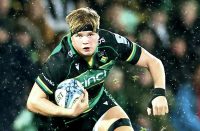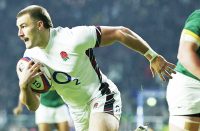 Stuart Lancaster must know by now that the biggest job he has as England head coach is selection. England are two years away from the 2015 World Cup, with only another 20 or so international games left to get themselves in a position to win it. That challenge will test Lancaster’s selection skills to the full.
Stuart Lancaster must know by now that the biggest job he has as England head coach is selection. England are two years away from the 2015 World Cup, with only another 20 or so international games left to get themselves in a position to win it. That challenge will test Lancaster’s selection skills to the full.
You can be the best organiser and have the best training and conditioning programmes and processes in place, but if you get selection wrong you will not achieve your goals.
This is a crucial time in terms of England selection, and I am sure Lancaster recognises that he has to start being ruthless. Above all, he has to make the right choices – and bear in mind that 12 months can be a long time in international rugby.
One of the things that I find difficult to understand is why Lancaster has said on a number of occasions that he is pretty much settled on his core group of players for 2015.
My view is that he should not limit his options two years before the tournament.
Being drawn in the same World Cup pool as Australia and Wales means that Lancaster has to make the right calls, and that has to include rewarding players who may not be in his plans currently, but show great form between now and the tournament.
Australia and Wales are two years ahead of England in knowing their best team – and both played in the semi-finals of the last World Cup.
I’m English, and an England supporter, and it is as clear as daylight to me that the side that lost to Wales in the final showdown of the 2013 Six Nations will not be good enough to beat Wales at the next World Cup. That means that the personnel in the England team have to change.
The only way for Lancaster to go is to pick the young talented players, and he did that for the tour to Argentina. That England squad excited me much more than the one he picked for the Six Nations.
The trademark of good teams is to score tries as well as to defend, and last season, after the Scotland game, England struggled to score tries. However, when you have the skill and speed of Kyle Eastmond, Freddie Burns, Billy Twelvetrees, Christian Wade, Jonny May and Marlon Yarde you put yourself in a much better position to do so.
And it’s not just the backs. Alex Corbisiero was fantastic in Australia for the Lions, Tom Youngs was also very good, and Geoff Parling defied his critics to make the test team. At the same time, Ben Morgan, Tom Wood, Billy Vunipola and Rob Webber showed well in Argentina.
This gives Lancaster a great opportunity to mix-and-match the steadiness brought by some of his Six Nations regulars of the last two seasons – players like Chris Robshaw, Dan Cole, Wood, Parling, Ben Youngs and Manu Tuilagi – with the new young thrusters from the Argentina tour mentioned above.
That should give him a side capable of beating opponents by scoring two to three tries a game. If that is your starting point, you cannot go too far wrong.
Lancaster has some big calls to make to get to that point. One of them concerns Owen Farrell at fly-half. As good a player as he is, Farrell lacks the basic speed to allow a backline to attack to its full potential.
The only way he can afford Farrell is if he has an incredibly talented inside-centre alongside, as Jonny Wilkinson did with Will Greenwood. It is possible that Twelvetrees could be Farrell’s version of Greenwood.
On the plus side, Lancaster has the luxury of two different fly-halves, with Farrell, who has limitations in attack but is very strong in defence, and Burns, who has great attacking qualities but is not the best defender.
Another big call involves Robshaw, and whether, if he has to, Lancaster can make a difficult decision in the same way Warren Gatland did with Brian O’Driscoll before the Lions third Test against Australia.
Lancaster has to find a more dynamic No.7, but I am a Robshaw fan. He is a phenomenal player with a tremendous workrate, but he does not turn-over or slow down enough opposition ball.That is why he is a blindside rather than and openside at international level.
If Matt Kvesic is the best England No.7 he will have to prove it at Gloucester, and he will have every chance to do so because they play a great brand of rugby. It is a big opportunity for him, but he has to prove he is better than Robshaw against better opposition than the Argentina second string.
Opensides are mainly carriers in the more structured modern game, but the first dynamic ball winner that Lancaster discovers should play for England.
Players select themselves by playing well, and then it’s a question of giving the right people experience. Sometimes player stats can also cloud selection issues, and that’s when a coach has to trust his instincts.
I have never believed that coaches should have pre-ordained ideas of how they want players to play. There are certain rules like ‘if you get turn-over ball don’t kick it away immediately’, but overall there is very little a coach can do at international level to develop a player. That should have been done already.
Lancaster has shown he is willing to learn from all quarters, but in the end he has to make the calls that turn England into a dynamic try-scoring team.
In Rugby Union it takes longer to build great attack than great defence, and more work.
It is attack that counts most, and you need to be smarter than the team opposite. That’s what the psyche of England’s coaches and players has to be.
2 Comments
Leave a Comment
You must be logged in to post a comment.























England need starting sub-units capable of besting the best (top 5 nations)
Front Row -Corbs, Cole and whichever hooker gives first 50 min dominance
Second Row – guile and grunt, Parling & Attwood with Launchbury 2nd half
Backrow – Morgan, Croft, + either Kvesic, Robshaw or a “bolter”
Halves – youngs and burns, care and farrell
Centres – Twelvetrees and Tuiilagi, or Eastmond and Jospeph
Back 3 – Foden, Yarde or Wade and Ashton?
Pingback: Devops services